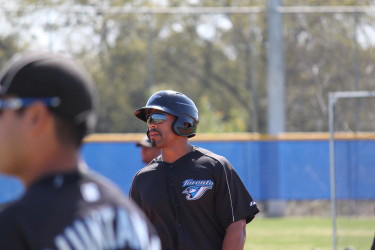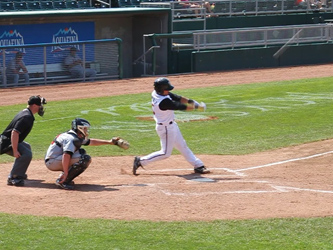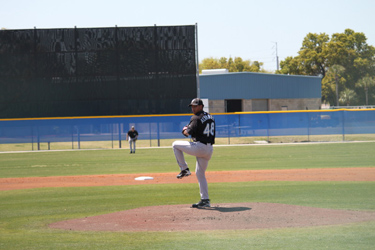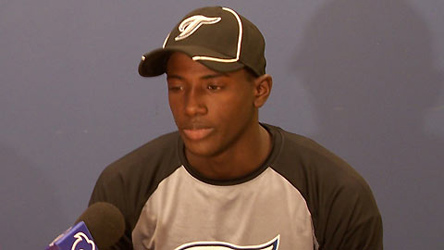
Today we wrap up our 2010 Blue Jays Top Prospects 30 with numbers 10-1. For 30-21 click here. For 20-11 click here.
10. Eric Thames, OF
Born November 10, 1986. Selected in the 7th round of the 2008 draft.
| Year | Age | Level | AB | 2B | 3B | HR | BB | K | SB | CS | AVG | OBP | SLG |
| 2009 |
22 |
Rk |
21 |
3 |
0 |
0 |
3 |
5 |
0 |
0 |
.286 |
.360 |
.429 |
| 2009 |
22 |
A+ |
195 |
15 |
5 |
3 |
21 | 40 | 1 |
1 |
.313 |
.386 |
.487 |
| 2010 |
23 |
AA |
496 |
25 |
6 |
27 |
50 |
121 |
8 |
5 |
.288 |
.370 |
.526 |
Entering the 2010 season Eric Thames had 216 professional at-bats in his career, a number he would more than double this year as he was finally able to stay healthy. After sustaining injuries in both 2008 and 2009 he decided to take up yoga, in an effort to increase his flexibility and prolong his career. Evidently the exercise paid off, as Thames hit .288 with 27 home runs to lead the Eastern League, even after being aggressively promoted to AA. Along the way he won the Blue Jays Webster Award for AA, made the Eastern League mid-season and post-season all-star teams, and was named an AA all-star by Baseball America.
The Blue Jay personnel haven't overhyped Thames, instead stressing how raw and inexperienced he is. He has an aggressive approach at the plate that may be reflective of his inexperience, as the jump to AA is considered one of the toughest in the minor league progression and to do it with so few at-bats makes it tougher still. As a result he struck out in nearly a quarter of his at bats in 2010, though individual months were better earlier in the season. His major league equivalent numbers for 2010 were a .244 average with 20 home runs and an OPS of 711, so he still has a ways to go in developing his offensive game. As a defender Thames is also a work in process, and he needs to improve his ability to track balls and make plays. He does have decent speed and his arm is OK, he just is not yet smooth as an outfielder. In 2011 Thames should improve his batting average in Las Vegas, and if this is matched by an improvement in his plate discipline he could be in Toronto by the end of the season.
9. Travis d'Arnaud, C
Born February 10, 1989. Selected in the the 1st round (supplemental) of the 2007 draft.
| Year | Age | Level | AB | 2B | 3B | HR | BB | K | SB | CS | AVG | OBP | SLG |
| 2007 |
18 |
RK |
141 |
3 |
0 |
4 |
4 |
23 |
4 |
2 |
.241 |
.278 |
.348 |
| 2008 |
19 |
A- |
175 |
13 |
1 |
4 |
18 |
29 |
1 |
2 |
.309 |
.371 |
.463 |
| 2008 |
19 |
A |
64 |
5 |
0 |
2 |
5 |
19 |
0 |
0 |
.297 |
.357 |
.469 |
| 2009 |
20 |
A |
482 |
38 |
1 |
13 |
41 |
75 |
8 |
4 |
.255 |
.319 |
.419 |
| 2010 |
21 |
A+ |
263 |
20 |
1 |
6 |
20 |
63 |
3 |
1 |
.259 |
.315 |
.411 |
8. AJ Jimenez, C
Born May 1, 1990. Selected in the 8th round of the 2007 draft.
| Year | Age | Level | AB | 2B | 3B | HR | BB | K | SB | CS | AVG | OBP | SLG |
| 2009 |
19 |
A |
278 |
15 |
1 |
3 |
7 |
72 |
5 |
2 |
.263 |
.280 |
.356 |
| 2010 |
20 |
A |
262 |
22 |
0 |
4 |
18 |
56 | 16 |
4 |
.305 |
.347 |
.435 |
| 2010 |
20 |
A+ |
9 |
0 |
0 |
1 |
0 |
5 |
0 |
0 |
.111 |
.111 |
.444 |

7. Henderson Alvarez, P
Born April 18, 1990. Signed out of Venezuela as a free agent.
| Year | Age | Level | G | GS | IP | H/9 | HR/9 | BB/9 | K/9 | ERA |
| 2007 |
17 |
DSL |
8 |
7 |
25.2 |
12.6 |
0.0 |
2.8 |
7.0 |
5.61 |
| 2008 |
18 |
Rk |
12 |
11 |
46.1 |
12.2 |
0.6 |
1.2 |
6.6 |
5.63 |
| 2009 |
19 |
A |
23 |
23 |
124.1 |
8.8 |
0.1 |
1.4 |
6.7 |
3.47 |
| 2010 |
20 |
A+ |
23 |
21 |
112.1 |
11.0 |
0.8 |
2.2 |
6.2 |
4.33 |

6. Deck McGuire, RHP
Born June 23, 1990. Selected in the first round of the 2010 draft.
| Year | Age | Level | G | GS | IP | H/9 | HR/9 | BB/9 | K/9 | ERA |
| 2008 |
19 |
NCAA | 17 |
13 |
78.0 |
8.08 |
0.92 |
3.69 |
8.08 |
3.46 |
| 2009 |
20 |
NCAA | 16 |
16 |
100.1 |
7.71 |
0.72 |
3.68 |
10.58 |
3.50 |
| 2010 |
21 | NCAA |
16 |
16 |
112.2 |
7.51 |
1.04 |
2.64 |
9.43 |
2.96 |
William Deck McGuire (that’s what it says on his birth certificate!) was the 11th overall pick in the 2010 out of Georgia Tech. McGuire signed a $2-million dollar deal just moments before the draft deadline in August That was $200-thousand above major league baseball’s slotting recommendation. Not bad for someone who was undrafted out of high school in Richmond, Virginia. The 6-foot-6, 215-pound righty won 28 of 35 decisions in his college career with the Yellow Jackets. He struck out 306 batters over 291 innings and was an all-American and ACC pitcher of the year in 2009.
According to McGuire, he is “a four pitch guy, my fastball is 90-94 and I do my best to run it and sink it. Sometimes it co-operates, sometimes it doesn’t. I try to locate my pitches, I won’t overpower anyone for the most part…I have a changeup and breaking ball and I use them sometimes to set up other pitches but...my strikeout pitches are my fastball and slider.”Andrew Tinnish, the Jays director of amateur scouting, says he likes the 21 year-old’s delivery, arm action and his 87 MPH sharp-breaking slider. He says McGuire has “got a good slider, he’s got a good changeup and he complements it with a curveball he can throw for strikes.”
The Jays feel McGuire will add about 15 to 20 pounds to his frame and hope he will team up with Jays 2009 first round pick Chad Jenkins in the starting rotation one day. One scout likened McGuire to Red Sox hurler John Lackey. He should expect an assignment to either Vancouver, Lansing or Dunedin in 2011.
5. Carlos Perez, C
Born October 27, 1990. Signed as an international free agent.
| Year | Age | Level | AB | 2B | 3B | HR | BB | K | SB | CS | AVG | OBP | SLG |
| 2008 |
17 |
DSL |
196 |
10 |
2 |
0 |
52 |
28 |
7 |
5 |
.306 |
.459 |
.378 |
| 2009 |
18 |
RK |
141 |
11 |
3 |
1 |
16 | 23 | 2 |
5 |
.291 |
.364 |
.433 |
| 2010 |
19 |
A- |
235 |
11 |
8 |
2 |
34 | 41 | 7 |
3 |
.298 |
.396 |
.438 |
4. Adeiny Hechavarria, SS
Born April 15, 1989. Signed out of Cuba for $10 million.
| Year | Age | Level | AB | 2B | 3B | HR | BB | K | SB | CS | AVG | OBP | SLG |
| 2010 |
21 |
A+ |
161 |
7 |
3 |
1 |
5 |
25 |
7 |
0 |
.193 |
.217 |
.292 |
| 2010 |
21 |
AA |
253 |
11 |
1 |
3 |
12 |
40 |
6 |
3 |
.273 |
.305 |
.360 |

3. Zach Stewart, RHP
Born September 28,1986. Selected in the 3rd round of the 2008 draft.
| Year | Age | Level | G | GS | IP | H/9 | HR/9 | BB/9 | K/9 | ERA |
| 2009 |
22 |
A+ |
7 |
7 |
42.1 |
10.00 |
0.21 |
1.70 |
6.81 |
2.13 |
| 2009 |
22 |
AA |
7 |
7 |
37.0 |
7.05 |
0.24 |
2.43 |
7.54 |
1.46 |
| 2009 |
22 |
AAA (CIN) |
9 |
0 |
12.1 |
8.05 |
0.00 |
5.85 |
11.70 |
0.73 |
| 2009 |
22 |
AAA (TOR) |
11 |
0 |
13.1 |
12.18 |
0.68 |
4.06 |
9.47 |
3.38 |
| 2009 |
23 |
AA |
26 |
26 |
136.3 |
8.65 |
0.86 |
3.57 |
7.00 |
3.63 |
In one of his last moves as GM of the Jays, J.P. Ricciardi acquired Stewart along with Josh Roenicke and Edwin Encarnacion in exchange for Scott Rolen at the 2009 MLB Trade Deadine. Drafted as a starter, Stewart was moved to relief in 2009 in part to keep control of his innings and in part because, well, that's where some people feel he's best suited. The Jays followed that plan for the remainder of the 2009 season but insisted starting was in his future. Sent back to AA to protect him from the unfriendly confines of the PCL, Stewart reverted to form quite nicely after a rough April and May. Stewart really shone in June and July where he went 6-1 with an ERA of 2.28 while helping form a dominant front half of the rotation along with Kyle Drabek.
While some people still feel as though Stewart's ultimate role will be that of a dominant reliever, the Jays will likely give him every chance to stick as a starter though there may not be much space in the major league rotation for some time if Kyle Drabek sticks in Spring Training. Stewart's calling card is a devastating sinker that can touch 95. He pairs this nicely with a hard slider and a change-up that is said to be much improved. He still struggles at times with his control but when he's on he induces lots of ground balls while still striking out his fair share.
2011 will be Stewart's age 24 season. He doesn't have much left to prove at AA but the Jays seem wary of exposing their top young arms to Las Vegas. If he has a nice spring it's feasible that Stewart could pitch out of the Toronto bullpen in April while being available to make spot starts in case of injury.
2. JP Arencibia, C
Born January 5, 1986. Selected in the 1st round of the 2007 draft.
| Year | Age | Level | AB | 2B | 3B | HR | BB | K | SB | CS | AVG | OBP | SLG |
| 2007 |
21 |
A- |
228 |
17 |
1 |
3 |
14 |
56 |
0 |
0 |
.254 |
.309 |
.377 |
| 2008 |
22 |
A+ |
248 |
22 |
0 |
13 |
11 |
46 |
0 |
0 |
.315 |
.344 |
.560 |
| 2008 |
22 |
AA |
262 |
14 |
0 |
14 |
7 |
55 |
0 |
0 |
.282 |
.302 |
.496 |
| 2009 |
23 |
AAA |
466 |
32 |
1 |
21 |
26 |
114 |
0 |
1 |
.236 |
.284 |
.444 |
| 2010 |
24 |
AAA |
412 |
36 |
1 |
32 |
38 |
85 |
0 |
0 |
.301 |
.359 |
.626 |
| 2010 |
24 |
MLB |
35 |
1 |
0 |
2 |
2 |
11 |
0 |
0 |
.143 |
.189 |
.343 |
This is likely to be a controversial ranking. How you see J.P. Arencibia as a prospect is dependent on two important things: how much you weigh his 2010 numbers compared to other years, and how much you believe those numbers were influenced by the Las Vegas hitting environment.
Of course, with any projection of future performance, the most recent data should always be weighted the most heavily, but previous data shouldn't be ignored. JPA had a pretty good year in 2008, but his plate discipline was awful. Then in 2009 he just had a bad year, posting an on base percentage of just .284. So what to make of his 2010? Did something click, or was it a fluke?
I was looking into this question a few weeks ago, using the major league equivalencies available at Minor League Splits. Unfortunately, the website has been taken down for the off-season, so I don't have exact numbers for you, but JPA's major league equivalency called for an OPS over .800, even factoring in the favourable Las Vegas hitting environment. Take that for what you will, I guess.
That doesn't mean his 2011 projection will be quite that sterling, since an MLE doesn't include data from previous seasons. If JPA gets the starting job next year, I would guess we'll see something like an OPS around .750, with a low OBP and 20-25 homers, and average to slightly-below defense.
That would be an excellent rookie season, and some improvement on that foundation would likely yield a slightly above average major league catcher over the next five years, at least. And that, to me, is worthy of #2 prospect status.
1. Kyle Drabek, P
Born December 18, 1987. Selected in the 1st round of the 2006 draft.
| Year | Age | Level | G | GS | IP | H/9 | HR/9 | BB/9 | K/9 | ERA |
| 2008 |
20 |
R |
4 |
4 |
12.0 |
4.50 |
1.5 |
4.5 |
4.50 |
2.25 |
| 2008 |
20 |
A- |
4 |
4 |
30.2 |
4.86 |
0.44 |
2.66 |
4.43 |
2.21 |
| 2009 |
21 |
A+ |
10 |
9 |
61.2 |
7.15 |
0.00 |
2.77 |
10.80 |
2.48 |
| 2009 |
21 |
AA |
15 |
14 |
96.1 |
8.61 |
0.84 |
2.90 |
7.10 |
3.64 |
| 2010 |
22 |
AA |
27 |
27 |
162.0 |
7.00 |
0.67 |
3.78 |
7.33 |
2.94 |
| 2010 |
22 |
MLB |
3 |
3 |
17.0 |
9.53 |
1.06 |
2.65 |
6.35 |
4.76 |
While there may have been some internal debate about other prospects on our top 30 list, one name was never in doubt. Kyle Drabek was a unanimous choice for our number one overall prospect in 2010, and probably would have been number one overall last year had the Halladay trade happened before our list came out. The son of a former Cy Young award winner, Doug Drabek, Drabek the younger has a strong pedigree and the tools to match. He throws a fastball that can reach up to 97 and sits comfortably in the mid-90s, and augments it with a power curveball. He also throws a changeup, and sporadically a slider, neither of which is a strong pitch at this juncture, certainly not when compared to his plus fastball and curve. In his third major league start against the Yankees he made a couple of hitters look silly fishing for 58 foot curveballs that broke somewhat ridiculously in front of the plate. (You can seem some spring training video of Drabek's 4 pitches - 5 if you differentiate between his 2 and 4 seem fastball - here.)
Despite this great stuff, Drabek hasn't struck out an inordinate amount of guys in the minors, whiffing about 7+ batters per nine innings over the past two years. His control also needs some work, as he had trouble finding the zone in AA this year. He does do a good job of keeping the ball down in the zone though and inducing ground balls, which help limit his home runs and will help him in the long run. After a strong 2010 in which he was named the Eastern League Pitcher of the Year, Drabek will have the inside track on the number five slot in the Blue Jays rotation in 2011, and if he fails to win it he will almost certainly be the first pitcher called up in the event of an injury. If he can get his K/BB ratio back over 2/1 he could be a strong contender for Rookie of the Year.
https://www.battersbox.ca/article.php?story=20101003221106571